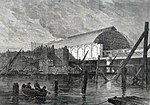Statue of James Outram, London

The statue of James Outram, a work by Matthew Noble, stands in Whitehall Gardens in London, south of Hungerford Bridge. It is a Grade II listed structure. Unusually, the plan to erect the statue began in Outram's own lifetime, at a public meeting held in Willis's Rooms, London, on 5 March 1861. The general had recently returned to Britain from India, the stage on which his military career had been played out, due to poor health. It was decided to erect an equestrian monument in Calcutta, with J. H. Foley as the sculptor, and a standing design by Matthew Noble in London, "near [the statue] of his illustrious comrade, Sir Henry Havelock", on Trafalgar Square. Permission for this site was refused by the First Commissioner of Works, who subsequently offered a site in the yet-to-be-created Embankment Gardens. The statue was unveiled by Lord Halifax, a former Secretary of State for India, on 17 August 1871.The bronze statue rests on a granite pedestal.
Excerpt from the Wikipedia article Statue of James Outram, London (License: CC BY-SA 3.0, Authors, Images).Statue of James Outram, London
Whitehall Place, City of Westminster Covent Garden
Geographical coordinates (GPS) Address Nearby Places Show on map
Geographical coordinates (GPS)
| Latitude | Longitude |
|---|---|
| N 51.5063 ° | E -0.12309 ° |
Address
Sir James Outram
Whitehall Place
WC2N 5DG City of Westminster, Covent Garden
England, United Kingdom
Open on Google Maps









